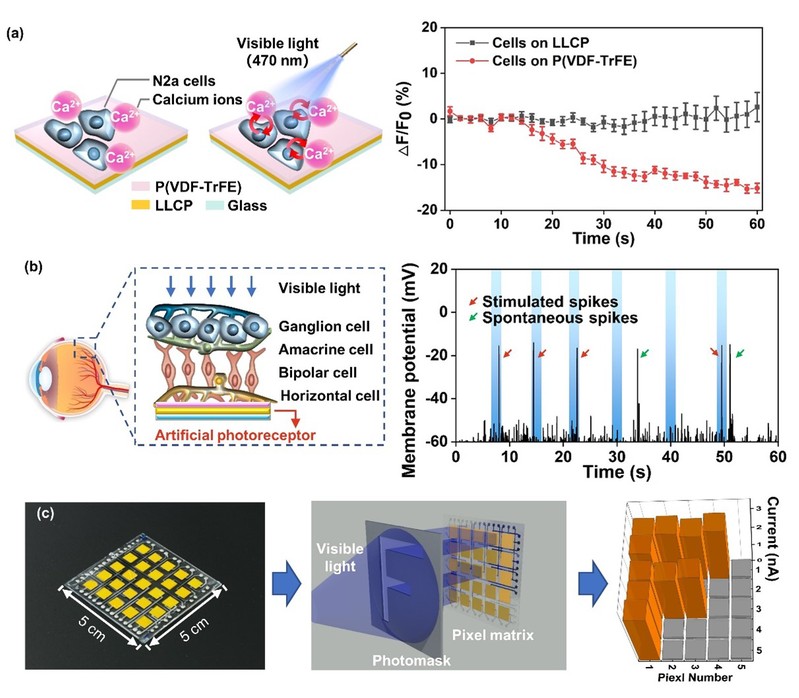搜索
Title: A Neuron-Readable Artificial Photoreceptor Composed of Photodeformable Liquid Crystal Polymers and Piezoelectric Materials
Author: Bo Peng, Xueli Chen, Guodong Yu, Fan Xu, Ruyi Yang, Zhenghang Yu, Jia Wei, Guodong Zhu, Lang Qin, Jiayi Zhang, Qundong Shen, Yanlei Yu*
Journal: Adv. Funct. Mater., 2023, 33(23), 2214172
Abstract:
Artificial photoreceptors are extensively developed to help the patients with serious eye diseases by converting light into electric signals. However, the existing systems still suffer from poor output signals, restricting signal transduction to cells. Here, a neuron-readable artificial photoreceptor with significant voltage output is constructed by using photodeformable liquid crystal polymers (LCPs) and polyvinylidene fluoride trifluoroethylene (P(VDF-TrFE)). The significant voltage output originates from light-stress-electricity conversion, where the photo-induced stress is attributed to the free volume expansion of the photodeformable LCPs and subsequently converts them into strong electric signals by the P(VDF-TrFE) layer. The photo-induced open-circuit voltage reaches up to 0.79 ± 0.02 V, which is, to the knowledge, 19 times higher than the maximum voltage (0.04 V) that has been reported to date. Hence, such artificial photoreceptor successfully transduces photo-induced electric signals to cells and tissues, communicates with the neurons, and triggers spiking activities in blind retinas. Besides, visual image recognition is demonstrated in a pixelated matrix by analyzing electric signals of each unit. This artificial photoreceptor opens new opportunities for the combination of the photodeformability and piezoelectricity, providing an avenue to develop neuron-readable artificial retinas and implantable sensors.
论文链接:https://onlinelibrary.wiley.com/doi/10.1002/adfm.202214172
PDF下载:![]() A Neuron-Readable Artificial Photoreceptor Composed of Photodeformable Liquid Crystal Polymers and Piezoelectric Materials.pdf
A Neuron-Readable Artificial Photoreceptor Composed of Photodeformable Liquid Crystal Polymers and Piezoelectric Materials.pdf
论文速递:
视觉是人类获取外界信息的重要途径,视觉功能受损或缺失会给生活带来诸多不便。由于缺乏有效的治疗方案,盲症的治疗一直是世界性难题,人工光感受器可以替代天然感受器细胞将光信号转换为电信号,为治疗提供新方案。但目前的人工光感受器光电信号较小,限制了信号传导到细胞。
为了增强光电信号,复旦大学材料科学系俞燕蕾教授团队报道了一种光致形变液晶聚合物与压电聚合物复合构筑的人工光感受器,通过光-应力-电信号的转换,在蓝光照射下产生高达0.79 ± 0.02 V的开路电压,是目前报道的相同原理最大值的19倍。这种人工光感受器由玻璃基板上的四层结构构成,包括光致形变层、压电层和两层导电电极(图1a)。当470 nm光照射到光致形变液晶聚合物时,偶氮苯基团trans-cis-trans异构化导致的自由体积膨胀(图1b),有利于产生大尺度可逆光致形变,提升光-应力转换过程中光致应力,这是提升人工光感受器电信号输出能力的关键。光致应力通过多层紧密贴合的结构传递到压电材料层,使其中的偶极子密度发生变化,从而产生电信号(图1c)。

图1.(a)人工光感受器的结构和组成成分结构式,包括液晶聚合物LLCP和压电聚合物P(VDF-TrFE);(b)液晶聚合物薄膜光致形变的示意图和照片;(c)人工光感受器的开路电压
得益于优异的电信号输出能力,这种人工光感受器能够成功引起神经元、视网膜和周围环境之间的信息交流。钙离子成像显示,培养在人工光感受器表面的神经元在光照下相对荧光强度降低,这是钙离子流入与流出打破了细胞内钙离子浓度平衡导致的(图2a)。在视网膜退化盲鼠模型中,进一步利用该人工光感受器替代坏死的天然光感受器,通过电生理信号检测,观察到了与光照密切相关的视网膜神经节细胞放电行为。以上结果表明光电信号成功传递到神经元和视网膜组织并引起了有效刺激(图2b)。这一过程与人类视网膜将光信号转换成电信号并传递给视神经的过程极为相似,在构筑人工视觉系统方面展现出潜力。人眼含有1 ~ 1.2亿个光感受器,共同承担视觉成像功能。受此启发,研究人员将多个人工光感受器集成并制备了5×5像素阵列,每个人工光感受器相当于一个像素点,光照区域与非光照区域的像素点电信号存在高达21倍的显著差异。通过分析每个像素点产生的电信号,展示了数字和字母等简单图案的识别功能(图2c)。这项研究推动了液晶聚合物植入式器件的发展,为神经可读的人工视网膜和智能器件开辟了全新的前景。

图2.(a)钙离子成像示意图及神经元相对荧光强度变化;(b)电生理信号检测示意图及视网膜神经节细胞的放电行为;(c)像素阵列照片及图案识别
相关研究成果被“高分子科学前沿”、“高分子科技”和“BioMed科技”微信官方公众号推送。
公众号推送链接:
https://mp.weixin.qq.com/s/4KJse5mZ3ohkILbffWCz2A(高分子科学前沿)








